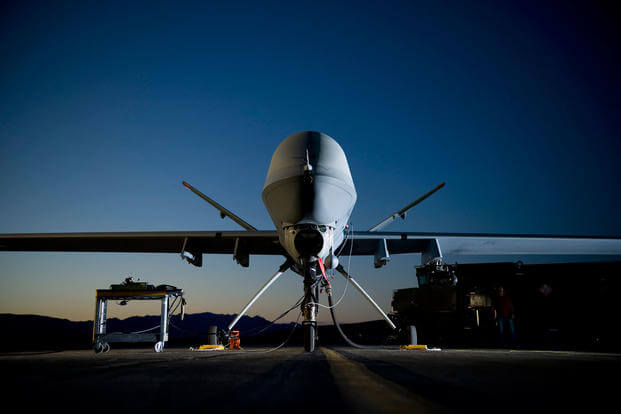U.S. warplanes, in a campaign now dubbed "Operation Odyssey Lightning," hit ISIS targets in the Libyan port city of Sirte again Tuesday, bringing the total number of airstrikes over the past two days to seven, the Pentagon said.
A combination of U.S. manned and unmanned aircraft using precision-guided weapons carried out the strikes in support of Libya's Government of National Accord (GNA) based in Tripoli, said Navy Capt. Jeff Davis, a Pentagon spokesman.
At least two of the airstrikes were carried out by Marine Corps Harrier jump jets flying off the amphibious assault ship Wasp off the Libyan coast, Fox News reported.
Five strikes on Monday hit a variety of targets, including an aging Soviet-era T-72 tank acquired under the regime of the late Libyan dictator Moammar Gadhafi, Davis said. Two more strikes Tuesday hit a rocket launcher and a heavy equipment excavator, he said.
Davis declined to say where the flights approved by Marine Gen. Thomas Waldhauser, the new commander of U.S. Africa Command, originated from, but Italy signaled a willingness to allow the use of its Sigonella air base in Sicily for additional strikes in support of the GNA.
Davis said the U.S. was prepared to carry out additional strikes "with the objective of helping the GNA take Sirte. We don't envision this as something that's going to last too long. They need help getting across the finish line" to take the city, he said.
At the White House, President Obama said the strikes were conducted "at the request of [the Libyan] government. "It is in America's national security interests in our fight against ISIL to make sure that they're able to finish the job," Obama said, using another acronym for the Islamic State of Iraq and Syria.
However, Davis confirmed that the strikes against ISIS in Sirte were part of a "new phase" of U.S. involvement in what could be considered yet another civil war in the Mideast. The U.S. conducted previous airstrikes in Libya in February and last November, but those strikes were described as "counter-terror" missions against "high-value" ISIS individuals, Davis said.
The current airstrikes in Libya were in support of the GNA , which has been endorsed as the legitimate government by the United Nations and consists of multiple militia factions in its armed wing. The GNA is opposed by a separate, self-declared government in eastern Libya based in Tobruk near the Egyptian border, which also is backed by multiple militia factions.
'Nominating' Targets
As described by Davis, the latest airstrikes were coordinated through a multi-layered target selection and forward air control system that the U.S. has employed in Iraq and Syria to support local forces on the ground.
GNA forces besieging Sirte were "nominating" targets.
"We have a close relationship with them where we have direct contact," Davis said, but he declined to describe the method of communication. The nominated targets were then evaluated by a Joint Terminal Attack Controller at an operations center in the region using live aerial surveillance. The JTAC would then give approval or disapproval for a strike to the manned or unmanned aircraft on station, Davis said.
To illustrate how the system works, Davis singled out the strike that took out the T-72 tank on Monday. The tank was used by ISIS fighters to control a neighborhood in southwestern Sirte, Davis said, and "it remained a problem for GNA forces. It was used repeatedly to beat back advances."
The tank was "nominated" for a strike that was carried out quickly, allowing the GNA forces to push back the ISIS fighters and gain control of the neighborhood, said Davis, who estimated that the ISIS forces remaining in the city now numbered in the "several hundreds." He said the airstrikes were limited to the retaking of Sirte, but the U.S. commitment to the GNA would continue.
On Italian state television Tuesday, Foreign Minister Paolo Gentiloni said his government would approve the use of the Sigonella air base in Sicily for U.S. strikes in Libya if Washington made the request, the Associated Press reported.
"I believe that it's a very positive fact" that the U.S has decided to intervene, Gentiloni said. He noted that the extremists were concentrated in four or five compounds in Sirte, but he expected that the GNA forces would have a difficult time ousting them
More Strikes in Yemen
At the same time that Davis was briefing on Syria, U.S. Central Command put out a statement on the latest U.S. counter-terror airstrikes in Yemen, where another civil war is raging involving tribal Houthi rebels and government forces backed by Saudi Arabia.
The statement said that a strike on July 8 killed one member of the Al Qaida in the Arabian Peninsula terror group, or AQAP, and a strike on July 16 killed six AQAP operatives and injured one. "AQAP remains a significant threat to the region, the United States and beyond," the statement said, and AQAP was using the unrest in Yemen "to provide a haven from which to plan future attacks against our allies as well as the U.S. and its interests."
Several weeks ago, the U.S. sent a small team of Special Forces troops into Yemen in support of local forces and United Arab Emirates troops to retake the port city of Mukalla from AQAP. Davis declined to say whether the U.S. team was still on the ground in Yemen but said that U.S. troops were periodically sent into Yemen.
-- Richard Sisk can be reached at Richard.Sisk@Military.com.
Related Video:
Five Things You Don’t Know: ISIS






























